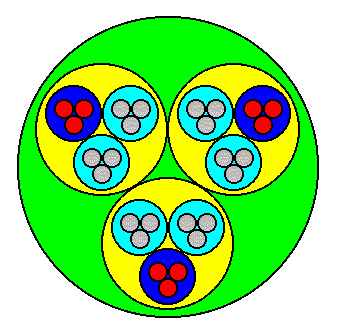
e-mail :

Orientation
The subject of the first half of our website, and as such directly introduced on our HOMEPAGE, is the search for the E s s e n c e, i.e. the intrinsic cause of every single genuine b e i n g. There we discovered that the Essence of a being (i.e. of a thing) is equivalent to the D y n a m i c a l L a w of that dynamical system that generated, or could have generated, that being (thing).
This dynamical law or essence resides at the "genotypical level" (or domain) of the thing, which means that it exists in an a b s t r a c t way. This dynamical law produces a multitude of v i s i b l e e f f e c t s. These effects reside at the "phenotypical level" (or domain) of the thing, which means that they exist in a concrete non-abstract way.
There are many such effects, and they display themselves as genuine properties of the given thing. In order to deepen our insight with respect to the t h i n g a n d i t s E s s e n c e, its intrinsic cause, a study of the effects of the Essence of a given thing, conferring on it its specific identity and appearance, would be in place. But because there are so many of such phenotypical effects, and so many different things on which these effects are imposed, we can study only a few of them. And because our intention is general -- just a general consideration of the thing and its essence -- we can choose one (or two for that matter) of these effects (just serving as a valuable and informative example), one that is well accessible and relatively well understood. We have chosen SYMMETRY AND FORM, and these with respect to two categories of objects, namely Crystals and Organisms.
For Crystals we did this by a consideration of conventional Crystallography, beginning with the first Essay of the Special Series (that can be accessed by first returning to the HOMEPAGE, and then scrolling the left frame to the Special Series).
For Organisms we have done so in the Documents (further below) on Promorphology, beginning with its Introduction.
Organisms have a different overall structure than (single) crystals do. So before we introduce Promorphology (which is geared to the symmetry and form of organisms) we must give an extensive exposition of the g e n e r a l s t r u c t u r e o f o r g a n i s m s.
So in this, and the ensuing documents we will treat of s t r u c t u r e, however not just of any structure, but a structure (only) insofar as it originates from a n o n - p e r i o d i c repetition of several more or less identical morphological units, as is the case in all organisms (and in a few types of inorganic beings). Such a repetition can occur in three ways (often coexistent with each other) :
This General Tectology of Organisms was for the first time developed by Ernst Haeckel in 1866, in his remarkable Generelle Morphologie der Organismen. Our own exposition is heavily based on the relevant chapters of this book. For more about Ernst Haeckel and his works, see our Introduction to Promorphology.
Although this Tectology, and also Promorphology, were established long ago (1866), they are hardly liable to become obsolete. This is because both theories are very general.
The fact that they have not been developed any further since Haeckel had introduced them, can be explained by a lack of interest into general matters. Almost every researcher is working on his own special subject, for instance a certain family or genus of animals. Within such a special research he can do fine without general considerations like we find them in General Tectology and Promorphology.
Tectology as a doctrine of organic individuality
Many researchers that were more or less philosophically inclined, were trying to find the genuine organic individuum. In higher animals it is easy to indicate the individual because of the correspondence to our own case. We can point easily to a human individual, for instance Socrates, and also to a canine individual, the dog Fido. But as soon as we decend to lower organisms it often becomes difficult to point to an individual. In the case of animals such organisms often seem colony-like. It is even harder in the case of plants.
These difficulties first of all led to the distinction between morphological individuum ( m o r p h o n t ) and physiological individuum ( b i o n t ), and in addition to that to the realization that the a b s o l u t e individuum cannot be established, because such an individuum does not exist. Most organisms turn out to be composed of a hierarchy of subordinated individuals, the higher ones comprising the lower ones. With this very feature the t e c t o l o g i c a l s t r u c t u r e emerges. The general character of this structure, and thus of the subordination of individuals, can be diagrammed as follows. It can clearly be seen that the structure is (intrinsically) non-periodic.

Figure 1. Hierarchical ordering of units, together forming a whole (Holon). We see a repetition of larger sub-units around an imaginary axis (normal to the plane of the drawing) resulting in three such units. These three units do not however have the same orientation with respect to each other, so the stucture is non-periodic.
The red 'cells' in the above Figure are not repeated t h r o u g h o u t the structure, because there are also gray cells. The dark blue 'organ', composed of these cells, is also not repeated t h r o u g h o u t the structure. The yellow 'organ complex' is the smallest unit that is indeed so repeated : Here it is repeated around an axis, resulting in three such units. They are however differently orientated. Together (as 'antimers') they make up the whole, the holon. This holon is itself, by definition, not repeated anymore. All this implies that indeed the structure is non-periodic, and as such differing essentially from the structure as we find it in single crystals.
T e c t o l o g y o r t h e D o c t r i n e o f O r g a n i c S t r u c t u r e i s t h e o v e r a l l s c i e n c e c o n c e r n i n g t h e i n d i v i d u a l i t y o f t h e l i v i n g n a t u r a l b o d y , which in most cases is an aggregate of individuals of different order.
The task of Organic Tectology is accordingly to provide knowledge and explanation of the o r g a n i c i n d i v i d u a l i t y, i.e. insight in the natural laws, according to which the organic matter individualizes itself, and according to which most organisms constitute their body as a unified form-complex consisting of a number of subordinated individuals.
It is perhaps instructive to give the ancient definition of individuum :
"Something is an individual (individuum) if it is undivided in itself, and divided from others."
Morphological and Physiological Individuality
In our earlier expositions about the general i n d i v i d u a l (individuum), concerning inorganic as well as organic individuality, we distinguished between here-and-now individuals (semaphoronts) on the one hand and historical individuals on the other.
See, for some theoretical insight our Essays on individuality in the first part of this website (Accessible by first clicking on back to homepage , and then adress (via the left frame) the following Essays :
Non-classical Series : Principle of Individuation.
Classical Series : What is an Individuum? I, II, III.
Critical Series : The Species-Individuum Structure and (also the Essay) Historical Individuum, Here-and-now Individuum.
In these Essays individuality and its causes are investigated in very general terms.
A here-and-now individual is a single state (stadium) of a being, i.e. a being at a certain point in time of its existence. A historical individual is the total series of successive states (stadia) of a being (all the growth states of a crystal taken together, or all the growth states of an organism taken together).
With respect to o r g a n i c individuality, however, we must moreover distinguish between form individuals and functional individuals. A form individual is a statical morphological unit, that is or is not materially included into a larger whole, while a functional individual is a working unit, that exists independently, i.e. it is not materially included into a larger whole.
When considering organic morphological individuality in the context of Tectology we do not consider the historic individual, but only the here-and-now individual (semaphoront), because only the s t r u c t u r e, of the organism at a certain point in time is considered.
We will now give the definitions of the morphological and physiological individual, based on those of Haeckel (Generelle Morphologie der Organismen, p. 265/266) :
As M o r p h o l o g i c a l I n d i v i d u u m or organic form individual, we signify generally that unified form phenomenon that we encounter as a self-contained and formally continuous coherent whole. A whole from which one cannot remove any of its constituents, and a whole, such that one cannot at all split up into parts, without destroying the character of that whole. The morphological individual is accordingly a single coherent spatial magnitude (a spatial intrinsically uniform chunk), which we, at the moment of observation, consider to be as an u n c h a n g e a b l e form.
We will, once and for all, call the morphological individuals by the name M o r p h o n t s ( M o r p h o n t a )
As P h y s i o l o g i c a l I n d i v i d u u m or work individual, we signify that unified form phenomenon that we encounter as an organic being that is able to exist during a longer or shorter time span in virtue of its own activity. An existence which expresses itself in all cases in the execution of the most general organic function, self-maintenance. The physiological individual is accordingly a single coherent spatial magnitude (a spatial intrinsically uniform chunk), which we see to be alife and feed itself for a longer or shorter period, and which we therefore consider at the moment of observation, to be c h a n g e a b l e. Very often it is moreover able to reproduce and also to execute other life-functions.
We will, once and for all, call the physiological individuals by the name B i o n t s ( Bionta ).
The m o r p h o l o g i c a l i n d i v i d u a l i t y is devided into six distinct subordinated categories or o r d e r s o f i n d i v i d u a l s, and each of these orders appears in certain organisms as physiological individuum. For every type of organism a definite order of individuality is, as being the highest, characteristic and represents without exception the true physiological individuality, at least at the time of full maturity of the given organism.
The six Orders of Organic (morphological) Individuality are the following :
Before we will systematically treat of each order of morphological individuality, we will here succinctly expound the nature of them, and in what way they realize the tectological structure of organisms.
The tectological built-up starts with the ultimate life-units, the C e l l s.
These cells can form cell-fusions in two ways :
If the aggregation results in some regular pattern of cells, then an a n t i m e r in the broader sense, or a m e t a m e r in the braoder sense, is formed.
The concept "antimer in the broader sense" comprises "antimer in the narrow sense" plus "paramer".
The concept "metamer in the broader sense" comprises "metamer in the narrow sense" plus "epimer".
The antimers in the broader sense can originate in two ways (See Figures below) :
If such a person (as fifth-order form individual) is a constituent of a still higher-order form individual, namely a plant or animal colony (Cormus), then we will call such a person an o f f s h o o t (Blastus).
If the person is a free-living plant or animal, i.e. if it is at the same time the physiological individuum (Bion) (Engl. Biont), then we will call such a person just p e r s o n (persona or, equivalently, prosopon).
G e n u i n e persons, always display an articulation along their main axis, i.e. they consist of a chain of more or less differentiated metamers. Haeckel called such persons p r o s o p a c a t e n a t a (chain-persons). By reasons to be explained later we will call them a x i a l p e r s o n s (Personae axiales).
(So-called) S i m p l e persons on the other hand, do not display a true metameric structure. Metamers are here laterally budded. Haeckel called such persons p r o s o p a f r u t i c o s a (bush-persons). By reasons to be explained later, we will call them p l a n a r p e r s o n s (Personae planatae).
Genuine C o l o n i e s (Cormi), originate by lateral budding of persons, and thus consisting of a multitude of persons.
Colonies consisting of planar-persons will be called planar colonies (Cormi planati).
Colonies consisting of axial-persons will be called a x i a l c o l o n i e s (Cormi axiales).
REMARKS.
2. In P r o m o r p h o l o g y, which is the study of the stereometric basic forms of organisms or of their parts, and which will follow upon Tectology, a n t i m e r s and p a r a m e r s play a crucial role in determining these basic forms. However, only the number and the shape of the antimers or paramers matter in this respect. And it is because of this that in Promorphology we are not going to distinguish between antimers and paramers, but will indicate them just by the term antimer. It is then equivalent to the term antimer in the broader sense as was applied above. An advantage of doing so is to let Promorphology as independent as possible of the details of Tectology, and thus independent of its more or less speculative elements. Moreover, while Tectology does not consider the structure of the cell, and so does not direct itself to its parts, Promorphology happily speaks of the cell's a n t i m e r s, i.e. how many there are in a given case, and of what shape they are.
The next Figures will clarify the tectological relationships between the form individuals of different order, constituting an organismic body, and the relationships between these subordinated individuals and the body axes.
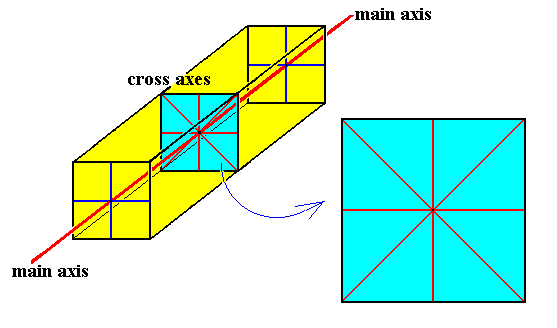
Figure 2. Diagram exemplifying the relationship between, and the position of, the main axis and the cross axes (in this example there are four cross axes) of an organismic body. This body's equatorial plane, in which the cross axes lie, is indicated in blue. Axial system is indicated in red.
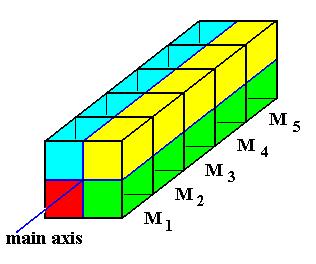
Figure 3. Diagram explaining the relationship between antimers (red, green, blue, yellow) and metamers ( M1, M2, M3, M4, M5 ). The m e t a m e r s are repetitions along the body's main axis. The a n t i m e r s are repetitions about the body's main axis.
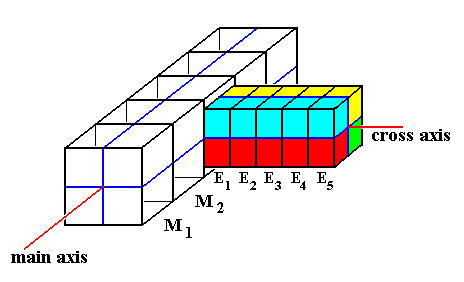
Figure 4. Diagram explaining the relationship between body trunk, paramers (red, green, blue, yellow) and epimers ( E1, E2, E3, E4, E5 ). The e p i m e r s are repetitions along a cross axis. The p a r a m e r s are repetitions about a cross axis.
It should, by the way, be clear that all organic individuals, without exception, may they reach, in their completed form, the highest state of complication, and consist of five different orders of individuals, like in the Vertebrates, or of six, as in most higher plants, only attain this complicated state by (individual) development, starting from the simplest individual of first order, a single cell, i.e. in the very beginning every organism is represented by such a first-order individual.
It will certainly be the case that not all tectological phenomena and relationships will neatly fit into this scheme. Nature often resists being forced into one or another scheme or system.
Having presented an introduction to the science of Tectology, we will now continue with a systematic treatment of it.
Again we will stress that the biological c e l l is the very unit of the tectological built-up of organisms. It is therefore also the unit of Tectology, and as such it is a first-order organic individual. In most cases it is so as a subordinated individual, i.e. as a constituent of a multicellular organic body, in other cases it appears as physiological individual, i.e. as a free-living cell, like in unicellular organisms.
The next Figure gives an impression of such a tectological unit, in this case a subordinated organic form individual.
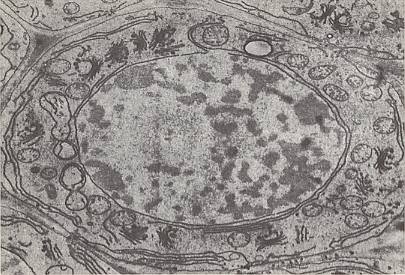
Figure 5. Young cell from the root of a corn plant. In the center we see the large cell nucleus. Between the nucleus and the cell wall we see the many cell organelles.
After BOGEN, H., Knaurs Buch der modernen Biology
Remark :
The ensuing systematic treatment (in the next documents) of the orders of organic individuality will mainly be a theoretic exposition. Details and (more) examples should be added by biologists with a general interest.
The next document will start our systematic Organic Tectology.
e-mail : 
To continue click HERE to go ahead with systematic Tectology
back to homepage
back to retrospect and continuation page
back to Internal Structure of 3-D Crystals
back to The Shapes of 3-D Crystals
back to The Thermodynamics of Crystals